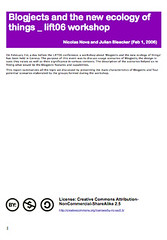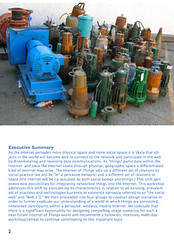From September 2005 to June 2006 a team of thirteen scholars at the The University of Southern California's Annenberg Center for Communication explored how new and maturing networking technologies are transforming the way in which we interact with content, media sources, other individuals and groups, and the world that surrounds us.
This site documents the process and the results.
categories
Reply to comment
Report from the Blogject Workshop at LIFT06
Nicolas and I have finished our Next Iteration on the Blogject project — our workshop report from Lift06..Read, Ponder, Complain and Disseminate.


On February 1st, a day before the LIFT06 conference, a workshop about ‘Blogjects and the new ecology of things’ was held in Geneva. The purpose of this event was to discuss usage scenarios of Blogjects, the design issues they raises as well as their significance in various contexts. The description of the scenarios helped us refining what would be the Blogjects features and capabilities.
This report (.pdf, 18.6Mb) summarizes all the topic we discussed by presenting the main characteristics of Blogjects and four potential scenarios elaborated by the groups formed during the workshop.
As the Internet pervades more physical space and more social space it is likely that objects in the world will become able to connect to the network and participate in the web by disseminating and receiving data communications. As “things” participate within the Internet and once the Internet soaks through physical, geographic space a differentiated kind of Internet may arise. The Internet of Things sets up a different set of relations to social practice (we will be “in” a pervasive network) and a different set of relations to space (the Internet will be co-occupied by both social beings and things.) This shift generates new possibilities for integrating networked things into the Internet. This workshop addresses this shift by considering its characteristics in relation to an existing, prevalent set of practices and technologies currently in existence variously referred to as “the social web” and “Web 2.0.” We then proceeded into four groups to conduct design scenarios in order to further explicate our understanding of a world in which things are connected, networked participants within a pervasive, wireless, mobile Internet. We conclude that there is a significant opportunity for designing compelling usage scenarios for such a near-future Internet of Things world and recommend a follow on, intensive, multi-day workshop/retreat to continue contributing to this important topic.
Feel free to spread it, make any comment, reblog it!
Reply
.
.
